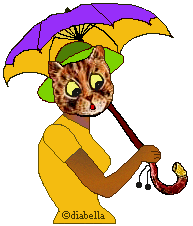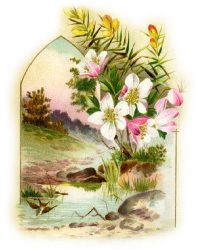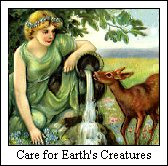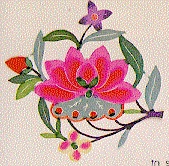|
|
 |
What Thomas Tusser actually wrote back in the sixteenth century was:
Sweet April Showers
 "April showers bring May flowers," say the Old Wives optimistically. To which Miss Stacy adds under her breath, "But by May the weeds are two feet high."
"April showers bring May flowers," say the Old Wives optimistically. To which Miss Stacy adds under her breath, "But by May the weeds are two feet high."
Do spring May flowers.
Miss Stacy likes to be precise about these things. Besides, she prefers Mr. Tusser's wording.
Another quotation, this one from The Canterbury Tales,
leads to writings that disturb Miss Stacy who feels that April is the time to clear away the rubble left by winter and to determine which shrubs and perennials have survived the cold and snow. It's no time to be travelling about the country staying at inns and sharing tales. There's weeding and planting to be done!
Whan that Aprille with his shoures soote
The droghte of March had perced to the roote
![]() [Topics:
Apples;
Word & Phrase Origins;
Companion Plants;
Yarrow]
[Topics:
Apples;
Word & Phrase Origins;
Companion Plants;
Yarrow]

Apples
27 April 2014 School children are taught the story of how apples were brought to the New World and how John Chapman ("Johnny Appleseed") carried a pouch of apple seeds when he travelled. His goal supposedly was to plant so many trees that no one would ever have to go hungry.
School children are taught the story of how apples were brought to the New World and how John Chapman ("Johnny Appleseed") carried a pouch of apple seeds when he travelled. His goal supposedly was to plant so many trees that no one would ever have to go hungry.
Many varieties are available for eating, for cooking, for making cider, or for making vinegar. Apples keep a long time when properly chilled; they can and freeze well, too. In pre-freezer times, apples were dried in thin slivers or cored and cut into rings. Rings were strung on a pole while slivers were spread out on boards. These were dried out in the sun or by the fireplace until brown and rubbery. They were turned frequently during the several days it took them to dry. Dried apples were stored in bags for use during the winter.
How does "an apple a day keep the doctor away"? Miss Stacy was told it is because apples are high in fiber (which her Gramma called "roughage" and in which she strongly believed) and low in fat. They're considered by many to be "nature's toothbrush" because eating an apple supposedly cleans the teeth. It does not.

This reminds Miss Stacy of an episode in the BBC sitcom Outnumbered in which little Karen is fretting about Friday the Thirteen. She's been told that it refers to Good Friday, so she asks, "If that's when they killed Jesus, why is it called GOOD Friday? It should be called BAD Friday."
Miss Stacy is pleased that others share her interest in words.
Word and Phrase Origins
20 April 2014
Old Wives are especially interested in origins. In how as well as in what. Miss Stacy is greatly interested in the origin of words i.e. in etymology and is always eager to share a few.
They dined on mince, and slices of quince
Which they ate with a runcible spoon;
And hand in hand, on the edge of the sand,
They danced by the light of the moon,
The moon, The moon,
They danced by the light of the moon.
Why is thirteen so unpopular and Friday the Thirteenth said to be especially dire? This attitude isn't universal. It's conjectured that thirteen is considered unlucky because of Caesar's assassination on the Ides (13th) of March. There's a long-held superstition that Friday is the most unlucky day of the week.

Marigolds, especially Tagetes patula, are beneficial because they kill soil nematodes and repel whitefly. They make good and useful borders throughout the garden. They are much needed by potatoes and tomatoes.
Chamomile is often put in near a plant which isn't growing well and removed when the plant again begins to thrive since it is believed that leaving it permanently isn't a good idea. Foxglove is planted freely since it both assists growth and helps with disease resistance.
Parsley is a decorative enough use throughout the garden, fortunately, since the plants help repel greenfly. Old Wives plant parsley near tomatoes and asparagus. Plant it near a rose bush to strengthen the scent of the blossoms.
Companion Plants
13 April 2014
 Old Wives observed that some plants do better when grown with certain other plants. Companion plants interested them because they realized that some plants "doctor" other plants just as many plants are good medicines for people.
Old Wives observed that some plants do better when grown with certain other plants. Companion plants interested them because they realized that some plants "doctor" other plants just as many plants are good medicines for people.

Yarrow is sometimes confused with Queen Anne's Lace (wild carrots) since both are about the same size, bloom at the same time, and have flat tops and finely-divided leaves. Yarrow flowers are a duller white and aren't as lacelike. Yarrow flowers grow in clusters and have yellow centers whereas the Queen Anne's Lace grows in a cluster of small white flowers with a central dark purple flower.
Yarrow is used as a tonic and as a treatment for various ailments. Wrap leaves in a moist cloth (or wet cloth in a yarrow tea) and put on the brow to relieve headache. Put in the shoe to relieve sore feet or to treat blisters. Sprinkle powdered yarrow on minor wounds to stop bleeding.
A tea can be made by pouring very hot water over dry or green leaves in a cup. Steep only until color shows. Teas also can be made by steeping a teaspoon of dried yarrow flowers in a cup of hot water for 5-10 minutes. Such a tea can be drunk or used in a poultice to soothe itchy skin.
Fry yarrow greens in butter until they turn brown, add some sugar and serve hot. Adding a tablespoon of juice from a fresh orange is a good variation. Mix very young leaves into a green salad.
Pregnant women should not consume yarrow.
Yarrow
6 April 2014
 Attractive and cheery looking with flat-topped heads of white flowers, yarrow (Achillea millefolium) is more often found along roadsides and in fields than in gardens. It is a vigorous grower which must be kept in bounds, but it does have a place in a herb garden.
Attractive and cheery looking with flat-topped heads of white flowers, yarrow (Achillea millefolium) is more often found along roadsides and in fields than in gardens. It is a vigorous grower which must be kept in bounds, but it does have a place in a herb garden.

|
|
|
|
|
|
When to Plant; Weather Signs; Hummingbirds; Herbal Teas; Catnip.
|
Apples, Word & Phrase Origins, Companion Plants; Yarrow.
|
Snake Lore: Rattlesnakes, Copperheads, Cottonmouths, Coral, Garter Snake.
|

|
|
|
|

|
In process - topics so far this month: Death & Burial Customs
|


|
 site options |

|

 |
 |

|